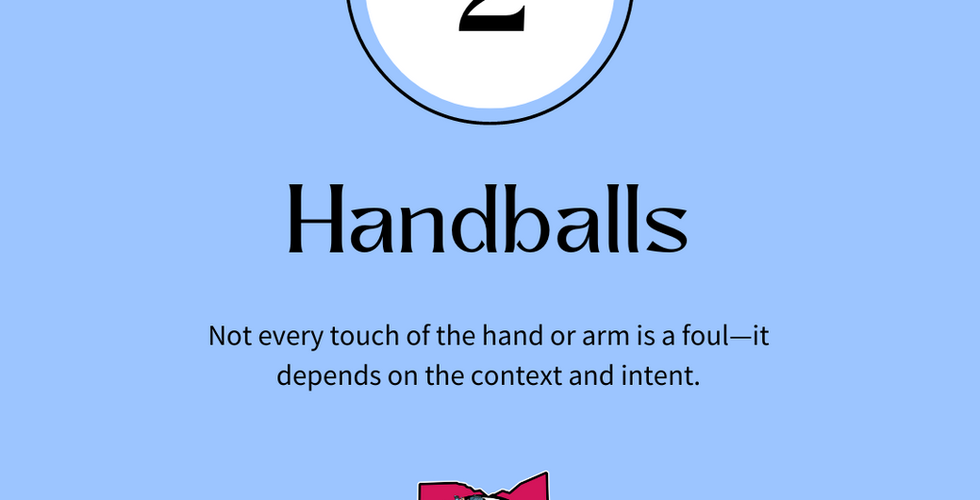The 5 Most Misunderstood Soccer Rules (and the Laws Behind Them)
- Jennifer Dunaway
- Oct 9, 2024
- 3 min read
Soccer is a beautiful game, but certain rules often leave fans, players, and even parents scratching their heads. Whether it's a confusing offside call or a handball debate, misunderstandings about the rules can affect the enjoyment and flow of the game. In this post, we’ll break down the five most misunderstood soccer rules and reference the corresponding Laws of the Game as outlined by the International Football Association Board (IFAB).
The offside rule remains one of the most controversial and complex rules in soccer. According to Law 11, a player is offside if, at the moment the ball is passed to them, they are:
Closer to the opponent’s goal line than both the ball and the second-to-last defender.
In an active position, interfering with play, or gaining an advantage.
Common Misunderstanding: Many people think a player is offside as long as they are behind the defense at any time during play. However, it only matters when the ball is played to them. If a player is behind the defense but runs back before the ball is passed, they are not offside.
Key Takeaway: Being in an offside position isn’t an offense in itself—it's about being involved in the play. You can read this older post where we explain offside in more detail here.
The handball rule, under Law 12, has changed recently, leading to more confusion. A handball is called when:
A player deliberately handles the ball with their hand or arm below the armpit.
The hand or arm is in an "unnatural position," meaning it's making the player’s body unnaturally bigger.
Accidental handball is penalized if it leads directly to a goal or creates a scoring opportunity.
Common Misunderstanding: Many believe any contact between the ball and hand is an automatic foul. In reality, accidental or incidental contact isn’t always penalized unless it provides a clear advantage.
Key Takeaway: Not every touch of the hand or arm is a foul—it depends on the context and intent.
The back-pass rule prohibits the goalkeeper from handling the ball when it is deliberately passed to them by a teammate using their feet. According to Law 12, the goalkeeper may only handle the ball if it’s passed using the head, chest, or knee.
Common Misunderstanding: Some assume any pass back to the goalkeeper counts as a violation. However, it’s only considered illegal if it is deliberately kicked by the foot. If the pass is from another body part (like the head), the goalkeeper is allowed to use their hands.
Key Takeaway: The goalkeeper can handle the ball from a back-pass, as long as it’s not deliberately kicked by a teammate's foot.
A throw-in is awarded when the ball fully crosses the touchline. Law 15 states that during a throw-in, the player must:
Keep both feet on or behind the touchline.
Use both hands to deliver the ball from behind and over the head.
Common Misunderstanding: Parents and players often miss the importance of foot positioning. Lifting a foot or failing to throw the ball properly over the head leads to a foul throw.
Key Takeaway: Both feet must remain on the ground, and the ball must be thrown with both hands over the head for a legal throw-in.
Once a goalkeeper gains control of the ball, Law 12 dictates they must release it within 6 seconds. The clock starts when the goalkeeper clearly has control and is able to restart play.
Common Misunderstanding: Many think the 6-second rule applies the moment the goalkeeper touches the ball. However, the rule actually applies when they are fully in control and not being obstructed by nearby players.
Key Takeaway: Goalkeepers have 6 seconds to release the ball once they’ve established full control of it.
Understanding these misunderstood soccer rules helps everyone enjoy the game more fully, from players and coaches to spectators. By referring back to the Laws of the Game, we can see that each of these rules has clear guidelines designed to make the game fair and competitive. So, next time an offside flag goes up or a handball is called, you’ll know exactly what’s happening on the field!
Sources:
IFAB Laws of the Game: https://www.theifab.com/laws
If you're looking to dive deeper into the official rules, check out the IFAB website for the complete Laws of the Game document.
.png)



















コメント